Effect of Nickel–Phosphorus and Nickel–Molybdenum Coatings on Electrical Ablation of Small Electromagnetic Rails
Abstract
1. Introduction
2. Experimental Equipment and Planning
2.1. Preparation of Small Electromagnetic Catapult Experiment Equipment
2.2. Deposition Process of Nickel–Phosphorus and Nickel–Molybdenum Coatings
2.3. Characterization of Rails
3. Results and Discussion
3.1. Rail Material/Coating Properties
3.2. Influencing Factors of Muzzle Velocity of Armature
3.3. Wear Analysis of the Rail’s Surface
3.4. Analysis of Surface Morphology, Elements and Structure of the Electrical Ablation Zone
4. Conclusions
- The hardness of these five tested materials is 215, 512, 650, 720 and 1045 HV for iron, nickel–phosphorus, annealed nickel–phosphorus, nickel–molybdenum, and annealed nickel–molybdenum, respectively. Heat treatment increases the hardness of the Ni–P and Ni–Mo coatings significantly, which can be ascribed to the precipitation of intermetallic compounds such as Ni3P precipitation for Ni–P and Ni4Mo precipitation for Ni–Mo coating.
- The contact resistance of the five rail-type materials is slightly higher than 0.2 Ω except for the annealed nickel–phosphorus-coated rail (0.186 Ω). However, its impact on the armature catapult velocity is not as obvious as the surface roughness of the rail. The sliding velocity of the armature decreases slightly with the increase in the surface roughness of the rail.
- During the catapult process, discontinuous and rapid electrical ablation on the rail surface was observed. The ratio of ablated area to the total area of these rails is: iron rail (19.5%) > Ni–P-coated rail (12.9%) > annealed Ni–P-coated rail (11.6%) > Ni–Mo-coated rail (4.9%) > annealed Ni–Mo-coated rail (1.1%). Our results show that the hardness of the rail material is an important factor for the resistance of electrical ablation.
- EDS analysis shows that there is more iron in the ablation area of nickel–phosphorus and annealed nickel–phosphorus-coated rails, indicating the iron from the armature material melted and transferred to nickel–phosphorus coating easily. On the contrary, the average value of iron in the ablation zone of annealed nickel–molybdenum coating is relatively small.
- XRD analysis of the ablation zone identifies the presence of Ni3P precipitation for nickel–phosphorus and annealed nickel–phosphorus-coated rails and Ni4Mo phase is observed for nickel–molybdenum and annealed nickel–molybdenum-coated rails. Therefore, it can be deduced that the rail surface of Ni–P and Ni–Mo systems can reach a high temperature that can induce the second phase precipitation. Most of the passing current is used for heating up the rail material and less energy can be used to melt the armature, resulting in a decrease in electrical ablation. Thus, the thermal conductivity should also be an important factor for the rail material to withstand the electrical ablation.
Author Contributions
Funding
Acknowledgments
Conflicts of Interest
References
- Ma, W.; Lu, J. Thinking and study of electromagnetic launch technology. IEEE Trans. Plasma Sci. 2017, 45, 1071–1077. [Google Scholar] [CrossRef]
- Poltanov, A.; Jygailo, N.; Bykov, M.; Glinov, A.; Svobodov, A.; Belyakov, A.; Chernetskaya, N. Study of new materials for rail gun launchers. IEEE Trans. Magn. 1997, 33, 406–409. [Google Scholar] [CrossRef]
- An, S.; Kim, S.H.; Lee, Y.H.; Yang, K.S.; Jin, Y.S.; Kim, Y.B.; Kim, J.; Cho, C.; Yoon, S.H.; Koo, I.S. Operation of a 2.4-MJ Pulsed Power System for Rail gun. IEEE Trans. Plasma Sci. 2013, 42, 2886–2890. [Google Scholar]
- Andrianov, V.V.; Baev, V.P.; Kazantsev, N.A.; Ostashev, V.E.; Parizh, M.B.; Sheinkman, V.S. A Variable Inductor Circuit Design for Inductive Energy Storage Systems. Rev. Sci. Instrum. 1990, 61, 1537–1542. [Google Scholar] [CrossRef]
- Han, Y.; Lin, F.; Dai, L.; Zou, L.; Wang, L.; Liu, G.; Bo, L. Analysis of Electric Parameters of a PPS System and Their Influence on Muzzle Velocity in EMG. IEEE Trans. Magn. 2009, 45, 559–563. [Google Scholar]
- Stankevic, T.; Schneider, M.; Balevicius, S. Magnetic Diffusion inside the Rails of an Electromagnetic Launcher Experimental and Numerical Studies. IEEE Trans. Plasma Sci. 2013, 41, 2790–2795. [Google Scholar] [CrossRef]
- Tarcza, K.R.; Weldon, W.F. Metal Gouging at Low Relative Sliding Velocities. Wear 1997, 209, 21–30. [Google Scholar] [CrossRef]
- Aigner, S.; Igenbergs, E. Friction and Ablation Measurements in a Round Bore Rail Gun. IEEE Trans. Magn. 1989, 25, 33–39. [Google Scholar] [CrossRef]
- Persad, C.; Satapathy, S. Friction and Wear Sciences for a Highly Durable Rail Gun Weapon; Inst. Adv. Technol. Univ. Texas Austin: Austin, TX, USA, 2007; p. 512. [Google Scholar]
- Powell, J.; Zielinski, A. A Preliminary Study of Wear in the Solid-Armature Rail Gun; Inst. Adv. Technol. Univ. Texas Austin: Austin, TX, USA, 1997. [Google Scholar]
- Challita, A.; Chelluri, B.; Bauer, D.P. Minimizing Non-arcing Contact Material Deposition on Rails. IEEE Trans. Magn. 1995, 31, 134–137. [Google Scholar] [CrossRef]
- Colombo, G.R.; Otooni, M.; Evangelisti, M.P.; Colon, N.; Chu, E. Application of Coatings for Electromagnetic Gun Technology. IEEE Trans. Magn. 1995, 31, 704–708. [Google Scholar] [CrossRef]
- Siopis, M.J.; Neu, R.W. Materials Selection Exercise for Electromagnetic Launcher Rails. IEEE Trans. Magn. 2013, 49, 4831–4838. [Google Scholar] [CrossRef]
- Watt, T.; Motes, D.T. The Effect of Surface Coating on the Onset of Rail Gouging. IEEE Trans. Plasma Sci. 2011, 39, 168–173. [Google Scholar] [CrossRef]
- McNeal, C.J. Barrel Wear Reduction in Rail Guns: The Effects of Known and Controlled Rail Spacing on Low Voltage Electrical Contact and the Hard Chrome Plating of Copper-Tungsten Rail and Pure Copper Rails. Master’s Thesis, Naval Postgraduate School, Monterey, CA, USA, 2003. [Google Scholar]
- Fayyad, P.M.; Abdullah, A.M.; Hassan, M.K.; Mohamed, A.M.; Jarjoura, G.; Farhat, Z. Recent advances in electroless-plated Ni-P and its composites for erosion and corrosion applications: A review. Emergent Mater. 2018, 1, 3–24. [Google Scholar] [CrossRef]
- Zhang, H.; Zou, J.; Lin, N.; Tang, B. Review on electroless plating Ni–P coatings for improving surface performance of steel. Surf. Rev. Lett. 2014, 21, 1430002. [Google Scholar] [CrossRef]
- Lima-Neto, P.; Correia, A.N.; Vaz, G.L.; Casciano, P.N.S. Morphological, Structural, Microhardness and Corrosion Characterisations of Electrodeposited Ni–Mo and Cr Coatings. J. Braz. Chem. Soc. 2010, 21, 1968–1976. [Google Scholar] [CrossRef]
- Sanches, L.S.; Domingues, S.H.; Marino, C.E.B.; Mascaro, L.H. Characterisation of electrochemically deposited Ni–Mo alloy coatings. Electrochem. Commun. 2004, 6, 543–548. [Google Scholar] [CrossRef]
- Ma, C.; Wang, S.C.; Wang, L.P.; Walsh, F.C.; Woo, R.J. The electrodeposition and characterization of low-friction and wear-resistant Co–Ni–P coatings. Surf. Coat. Technol. 2013, 235, 495–505. [Google Scholar] [CrossRef]
- Chassaing, E.; Quang, K.V.; Wiart, R. Mechanism of Ni–Mo alloy electro deposition in citrate electrolytes. J. Appl. Electrochem. 1989, 19, 839–844. [Google Scholar] [CrossRef]
- Hou, K.H.; Jeng, M.C.; Ger, M.-D. A Study on the wear resistance characteristics of pulse electro forming Ni–P alloy coatings as plated. Wear 2007, 262, 833–844. [Google Scholar] [CrossRef]
- Hou, K.H.; Jeng, M.C.; Ger, M.D. The Heat Treatment Effects on the Structure and Wear Behavior of Pulse Electroforming Ni–P Alloy Coatings. J. Alloys Compd. 2007, 437, 289–297. [Google Scholar] [CrossRef]
- Huang, P.C.; Hou, K.H.; Sheu, H.H.; Ger, M.D.; Wang, G.L. Wear Properties of Ni–Mo Coatings Produced by Pulse Electroforming. Surf. Coat. Technol. 2014, 258, 639–645. [Google Scholar] [CrossRef]
- Huang, P.C.; Hou, K.H.; Wang, G.L.; Chen, M.L.; Wang, J.R. Corrosion Resistance of the Ni–Mo Alloy Coatings Related to Coating’s Electroplating Parameters. Int. J. Electrochem. Sci. 2015, 10, 4972–4984. [Google Scholar]
- Zhou, Y.; Yan, P.; Sun, Y.H.; Wang, J.; Li, M.T. A Simple Model of high-power thyristor and its application in Eml transient analysis. In Proceedings of the PPC 2009: IEEE Pulsed Power Conference, Washington, DC, USA, 28 June–2 July 2009; pp. 1299–1302. [Google Scholar]
- Zhou, Y.; Yan, P.; Sun, Y.; Zhang, D.; Li, M. Analysis on efficiency improvement with a distributed energy store rail gun. In Proceedings of the 2010 IEEE International Power Modulator and High Voltage Conference, Atlanta, GA, USA, 23–27 May 2010; pp. 587–589. [Google Scholar]
- Hoffman, D.J.; Borraccini, J.P.; Swindler, S.B.; Petersen, L.J. Next Generation Power and Energy: Maybe Not So Next Generation. Naval Eng. J. 2010, 122, 59–74. [Google Scholar]
- Dong, J.; Zhang, J.; Li, J.; Gui, Y.; Cui, Y.; Li, S.; Su, N. The 100 Kj modular pulsed power units for rail gun. IEEE Trans. Plasma Sci. 2011, 39, 275–278. [Google Scholar] [CrossRef]
- Liu, P.; Yu, X.; Li, J.; Li, S. Study on energy conversion efficiency of EM launcher with a capacitor based pulsed power system. IEEE Trans. Plasma Sci. 2013, 419, 1–4. [Google Scholar]
- Gao, J.; Liu, L.; Wu, Y.; Shen, B.; Hu, W. Electroless Ni–P–SiC composite coatings with superfine particles. Surf. Coat. Technol. 2006, 200, 5836–5842. [Google Scholar]
- Seo, M.H.; Kim, J.S.; Hwang, W.S.; Kim, D.J.; Hwang, S.S.; Chun, B.S. Characteristics of Ni–P alloy electrodeposited from a sulfamate bath. Surf. Coat. Technol. 2004, 176, 135–140. [Google Scholar] [CrossRef]
- Archard, J.F. Contact and Rubbing of Flat Surfaces. J. Appl. Phys. 1953, 24, 981–988. [Google Scholar] [CrossRef]
- Duncan, R.N. The metallurgical structure of electroless nickel deposits: Effect on coating properties. Plat. Surf. Finish. 1996, 83, 65–69. [Google Scholar]
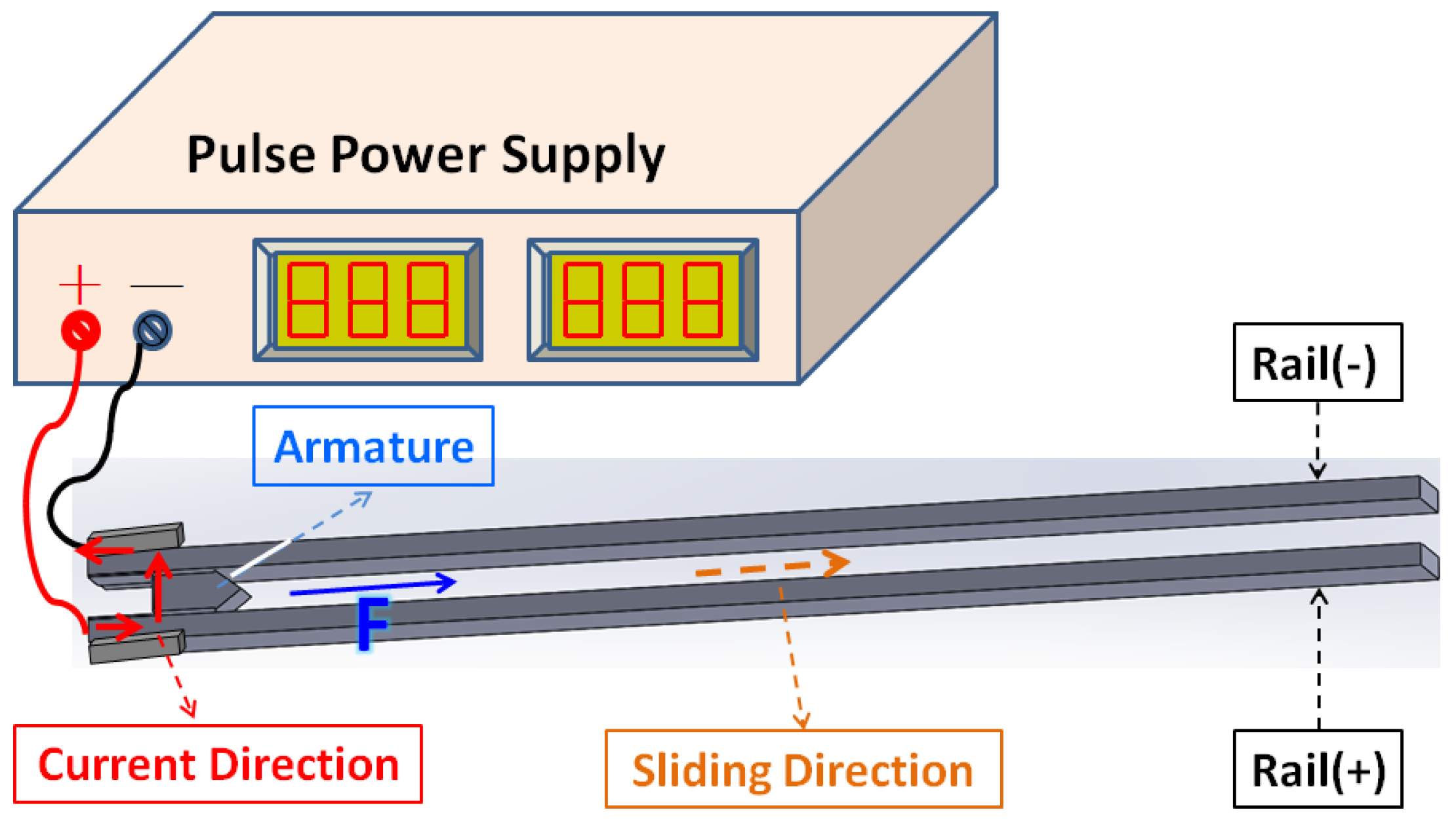

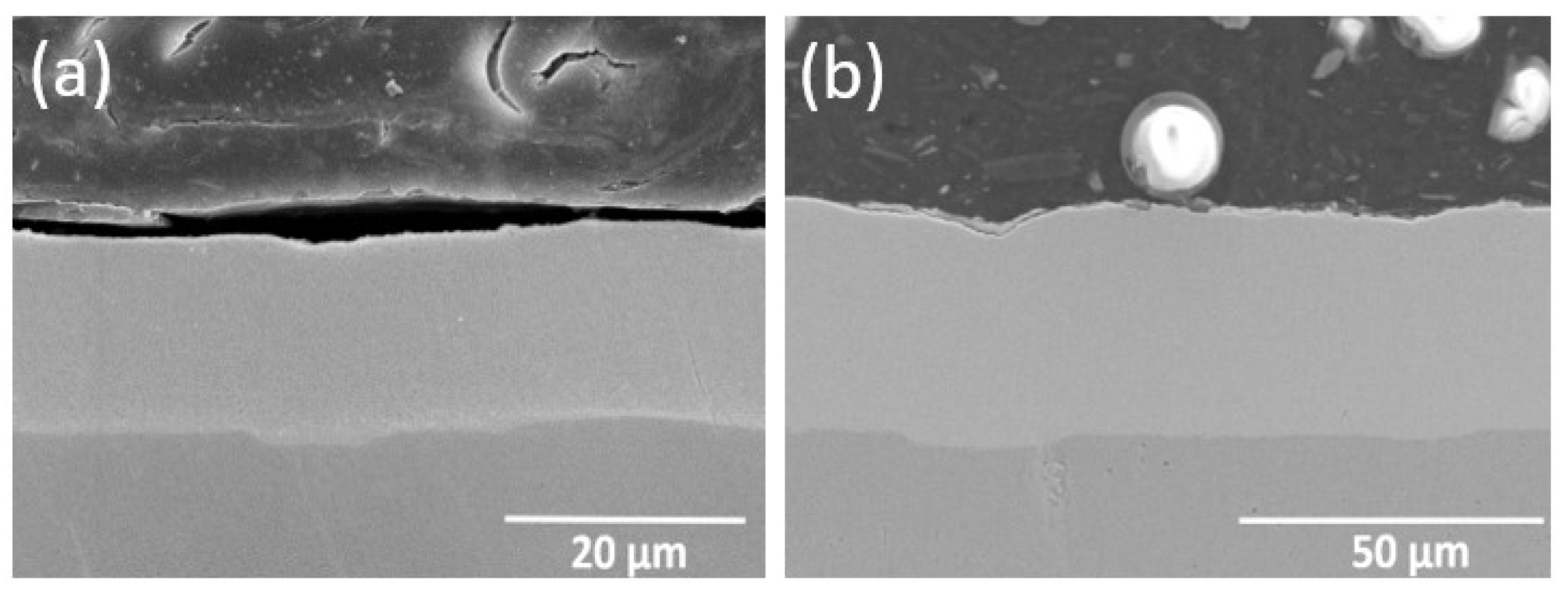

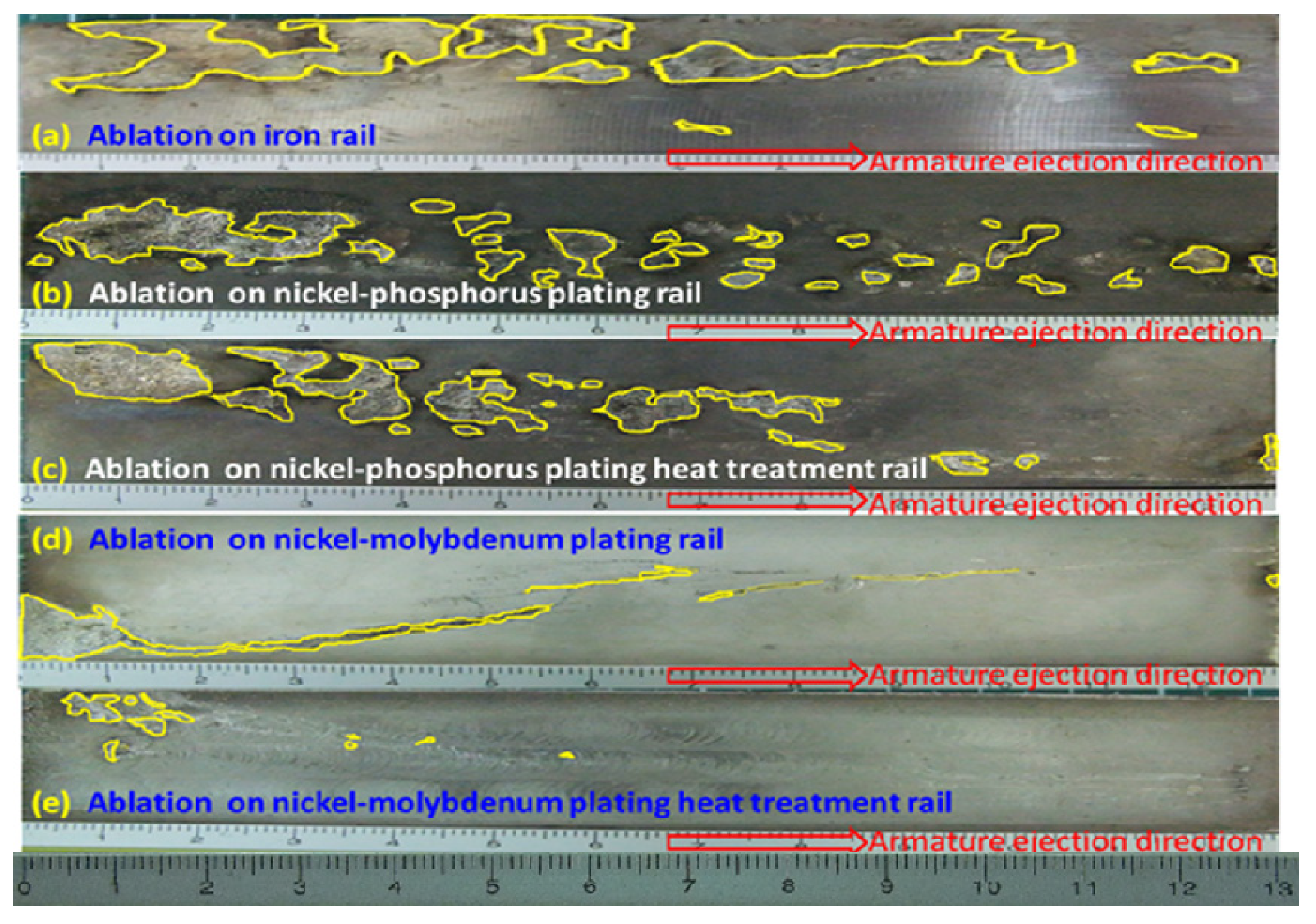

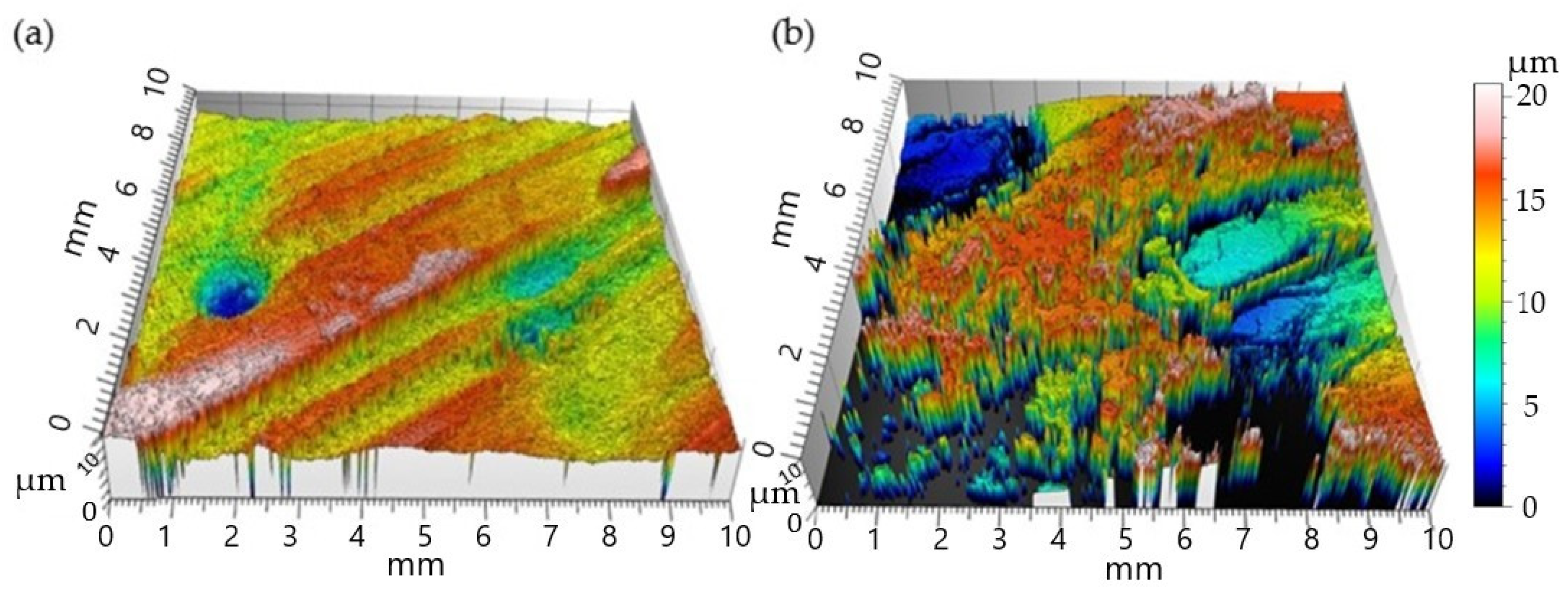
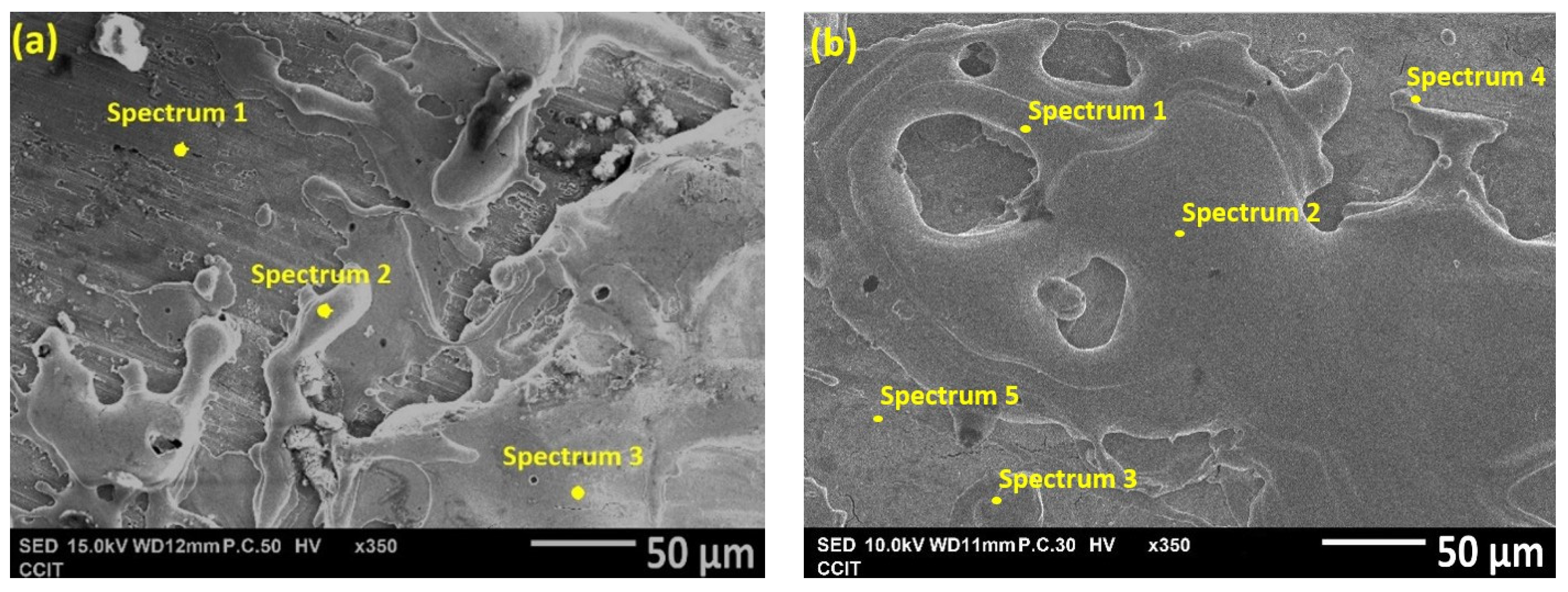
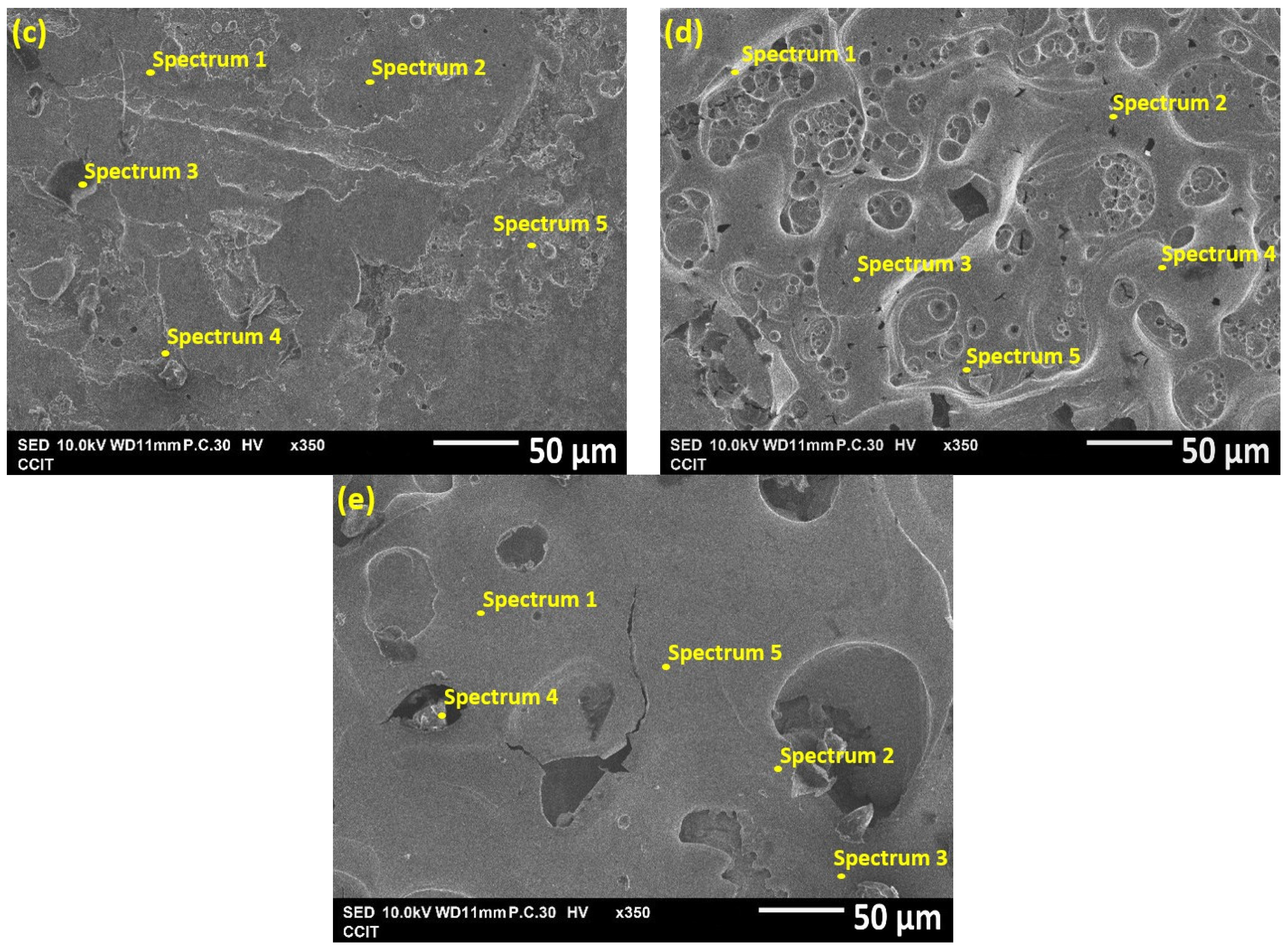

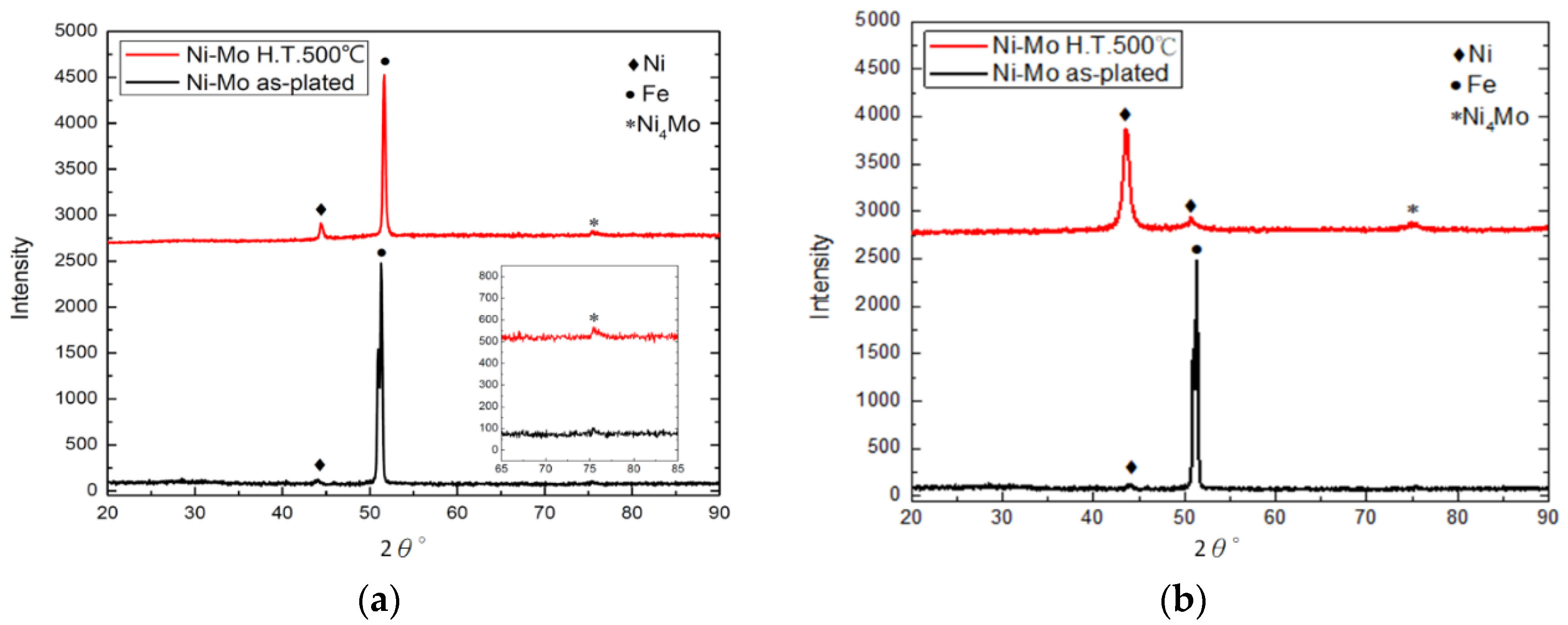
| Plating Solution Composition | |
|---|---|
| Nickel Sulfate Hexahydrate (NiSO46H2O) | 30 g/L |
| Sodium Lactate (C3H5NaO3) | 40 mL/L |
| Amino Acid Glycine (C2H5NO2) | 10 g/L |
| Sodium Hypophosphite (NaPO2H2) | 30 g/L |
| Potassium Iodate (KIO3) | 2 mL/L |
| Lead Nitrate (PbNO3) | 0.15 mL/L |
| Plating Solution Composition | |
|---|---|
| Nickel Sulfate Hexahydrate (NiSO46H2O) | 52.57 g/L |
| Sodium Molybdate dihydrate (MoNa2O4·2H2O) | 9.678 g/L |
| Sodium Citrate (Na3C6H507) | 58.82 g/L |
| Material | Iron | Ni–P Coating | Ni–P Coating Heat-Treated at 400 °C/1 h | Ni–Mo Coating | Ni–Mo Coating Heat-Treated at 500 °C/1 h | |
|---|---|---|---|---|---|---|
| Property | ||||||
| Hardness (HV) | 215 | 512 | 650 | 720 | 1045 | |
| Electrical Resistance (Ω) | 0.224 | 0.21 | 0.186 | 0.226 | 0.230 | |
| Surface Roughness (µm) | Ra 1.52 Sa 4.41 | Ra 3.41 Sa 5.01 | Ra 3.88 Sa 5.28 | Ra 4.05 Sa 5.09 | Ra 4.44 Sa 5.39 | |
| Surface Roughness | Before Catapult | After Catapult | |||
|---|---|---|---|---|---|
| Rail Type | Ra (µm) | Sa (µm) | Ra (µm) | Sa (µm) | |
| Iron rail | 1.52 | 4.41 | 4.49 | 6.59 | |
| Ni–P coating rail | 3.41 | 5.00 | 3.97 | 7.31 | |
| Ni–P HT. coating rail | 3.88 | 5.28 | 9.55 | 11.6 | |
| Ni–Mo coating rail | 4.05 | 5.09 | 6.15 | 7.63 | |
| Ni–Mo HT. coating rail | 4.44 | 5.39 | 4.41 | 5.26 | |
| Result | EDX Analysis (wt.%) | |||||||||
|---|---|---|---|---|---|---|---|---|---|---|
| Rail Kind | No. | Fe | C | Co | Cr | Ni | Mn | P | Mo | |
| Iron Rail | Spectrum 1 | 95.2 | 2.7 | 1.7 | 0.3 | – | – | – | – | |
| Spectrum 2 | 79.6 | 8.1 | 0.4 | 4.4 | 6.6 | 1.0 | – | – | ||
| Spectrum 3 | 85.3 | 2.8 | – | 3.8 | 7.0 | 1.1 | – | – | ||
| Nickel-Phosphorus Coated Rail | Spectrum 2 | 95.5 | – | – | – | – | – | 4.5 | – | |
| Spectrum 3 | 35.9 | – | – | 14.3 | 40.7 | – | 9.0 | – | ||
| Annealed Nickel–Phosphorus Coated Rail | Spectrum 2 | 64.2 | 22.3 | – | – | 13.1 | – | 0.4 | – | |
| Spectrum 4 | 0.2 | 98.8 | – | 0.1 | 0.9 | – | – | – | ||
| Nickel–Molybdenum Coated Rail | Spectrum 2 | – | 10.0 | – | 5.7 | 81.4 | – | – | 2.8 | |
| Spectrum 5 | 98.6 | – | – | – | 1.4 | – | – | – | ||
| Annealed Nickel–Molybdenum Coated Rail | Spectrum 1 | 45.1 | – | – | 2.9 | 37.0 | – | – | 15.0 | |
| Spectrum 2 | 23.7 | 6.4 | – | – | 46.9 | – | – | 23.0 | ||
Publisher’s Note: MDPI stays neutral with regard to jurisdictional claims in published maps and institutional affiliations. |
© 2020 by the authors. Licensee MDPI, Basel, Switzerland. This article is an open access article distributed under the terms and conditions of the Creative Commons Attribution (CC BY) license (http://creativecommons.org/licenses/by/4.0/).
Share and Cite
Hsu, L.-S.; Huang, P.-C.; Chou, C.-C.; Hou, K.-H.; Ger, M.-D.; Wang, G.-L. Effect of Nickel–Phosphorus and Nickel–Molybdenum Coatings on Electrical Ablation of Small Electromagnetic Rails. Coatings 2020, 10, 1082. https://doi.org/10.3390/coatings10111082
Hsu L-S, Huang P-C, Chou C-C, Hou K-H, Ger M-D, Wang G-L. Effect of Nickel–Phosphorus and Nickel–Molybdenum Coatings on Electrical Ablation of Small Electromagnetic Rails. Coatings. 2020; 10(11):1082. https://doi.org/10.3390/coatings10111082
Chicago/Turabian StyleHsu, Li-Shan, Pao-Chang Huang, Chih-Cheng Chou, Kung-Hsu Hou, Ming-Der Ger, and Gao-Liang Wang. 2020. "Effect of Nickel–Phosphorus and Nickel–Molybdenum Coatings on Electrical Ablation of Small Electromagnetic Rails" Coatings 10, no. 11: 1082. https://doi.org/10.3390/coatings10111082
APA StyleHsu, L.-S., Huang, P.-C., Chou, C.-C., Hou, K.-H., Ger, M.-D., & Wang, G.-L. (2020). Effect of Nickel–Phosphorus and Nickel–Molybdenum Coatings on Electrical Ablation of Small Electromagnetic Rails. Coatings, 10(11), 1082. https://doi.org/10.3390/coatings10111082





